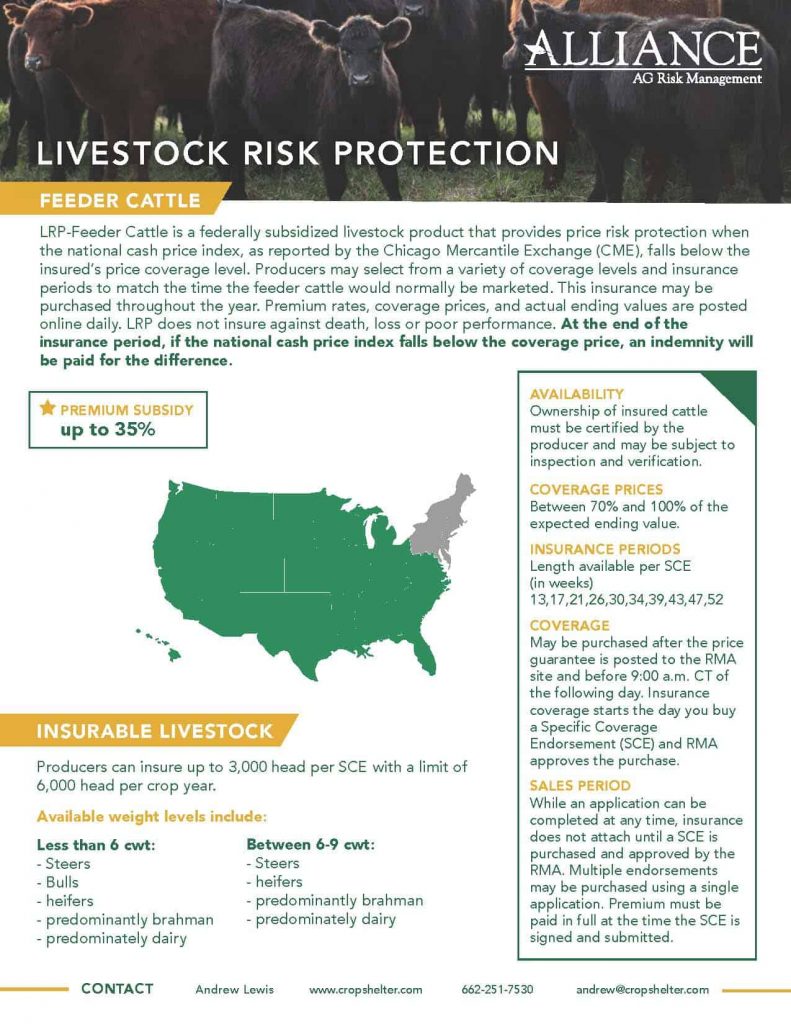Bagley Risk Management Solutions: Your Shield Versus Uncertainty
Bagley Risk Management Solutions: Your Shield Versus Uncertainty
Blog Article
Understanding Animals Danger Security (LRP) Insurance Policy: A Comprehensive Guide
Browsing the realm of livestock threat protection (LRP) insurance coverage can be an intricate venture for numerous in the farming industry. From how LRP insurance coverage functions to the different insurance coverage alternatives readily available, there is much to uncover in this detailed overview that might possibly shape the method animals manufacturers come close to danger monitoring in their services.

Exactly How LRP Insurance Works
Periodically, understanding the mechanics of Livestock Danger Defense (LRP) insurance can be complicated, however damaging down just how it works can supply clearness for farmers and breeders. LRP insurance policy is a threat monitoring device created to safeguard animals manufacturers versus unexpected cost declines. It's essential to keep in mind that LRP insurance policy is not a revenue guarantee; instead, it focuses solely on price threat protection.
Qualification and Insurance Coverage Options

When it comes to coverage alternatives, LRP insurance policy provides producers the flexibility to select the insurance coverage degree, protection period, and endorsements that best match their risk management demands. By recognizing the qualification criteria and insurance coverage choices readily available, animals manufacturers can make informed decisions to manage threat successfully.
Advantages And Disadvantages of LRP Insurance Coverage
When examining Livestock Risk Security (LRP) insurance coverage, it is important for livestock manufacturers to evaluate the advantages and downsides integral in this danger management tool.

One of the main benefits of LRP insurance policy is its capacity to provide security versus a decline in animals rates. Additionally, LRP insurance coverage uses a degree of flexibility, enabling producers to personalize insurance coverage degrees and plan periods to suit their specific needs.
One constraint of LRP insurance policy is that it does not safeguard versus all kinds of threats, such as condition break outs or all-natural calamities. It is critical for manufacturers to thoroughly analyze their individual risk direct exposure and economic circumstance to identify if LRP insurance policy is the appropriate risk monitoring device for their procedure.
Understanding LRP Insurance Policy Premiums

Tips for Taking Full Advantage Of LRP Benefits
Optimizing the advantages of Animals my blog Danger Protection (LRP) insurance coverage needs tactical preparation and aggressive risk management - Bagley Risk Management. To maximize your LRP coverage, think about the complying with pointers:
Routinely Examine Market Problems: Keep educated concerning market trends and rate fluctuations in the livestock industry. By checking these variables, you can make enlightened choices about when to purchase LRP protection to shield against potential losses.
Establish Realistic Coverage Levels: When choosing protection levels, consider your manufacturing prices, market price of animals, and prospective risks - Bagley Risk Management. Establishing reasonable coverage levels makes sure that you are sufficiently safeguarded without paying too much for unnecessary insurance coverage
Diversify Your Insurance Coverage: Rather of counting exclusively on LRP insurance coverage, consider diversifying your threat administration techniques. Integrating LRP with other threat administration Extra resources tools such as futures agreements or choices can offer thorough protection against market unpredictabilities.
Evaluation and Readjust Protection Consistently: As market conditions transform, periodically evaluate your LRP insurance coverage to ensure it aligns with your present danger exposure. Adjusting coverage levels and timing of acquisitions can help optimize your danger protection technique. By adhering to these ideas, you can take full advantage of the advantages of LRP insurance and safeguard your livestock procedure versus unanticipated risks.
Final Thought
To conclude, livestock threat protection (LRP) insurance coverage is a useful tool for farmers to take care of the financial dangers associated with their livestock procedures. By understanding exactly how LRP learn the facts here now works, eligibility and coverage choices, as well as the advantages and disadvantages of this insurance, farmers can make educated decisions to protect their source of incomes. By carefully thinking about LRP premiums and carrying out approaches to make best use of benefits, farmers can mitigate potential losses and make sure the sustainability of their procedures.
Animals producers interested in obtaining Livestock Threat Security (LRP) insurance can discover a variety of qualification standards and coverage choices tailored to their details animals operations.When it comes to insurance coverage choices, LRP insurance policy offers producers the versatility to pick the coverage level, protection period, and endorsements that finest fit their threat management needs.To grasp the intricacies of Livestock Risk Protection (LRP) insurance fully, comprehending the elements influencing LRP insurance costs is vital. LRP insurance coverage premiums are determined by various elements, consisting of the coverage degree picked, the expected cost of livestock at the end of the coverage duration, the type of livestock being guaranteed, and the size of the coverage duration.Evaluation and Adjust Insurance Coverage Frequently: As market problems alter, regularly review your LRP protection to ensure it lines up with your existing risk direct exposure.
Report this page